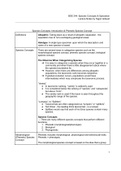Class notes
BDE 244: Species Concepts and Speciation
- Course
- Institution
A 46 page collection of all information covered in the lectures of BDE 244 Species Concepts and Speciation. These notes contains the given work from the lectures as well as extra definitions, explanations and diagrams from online resources. Tables and bullet points are used to aid memorisation.
[Show more]



